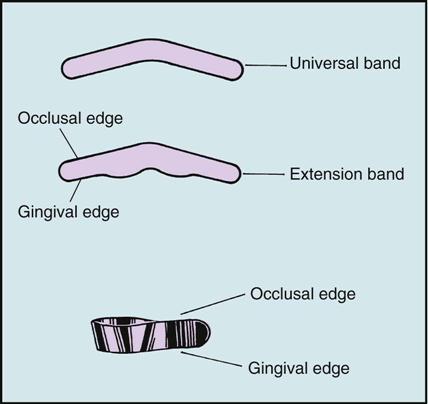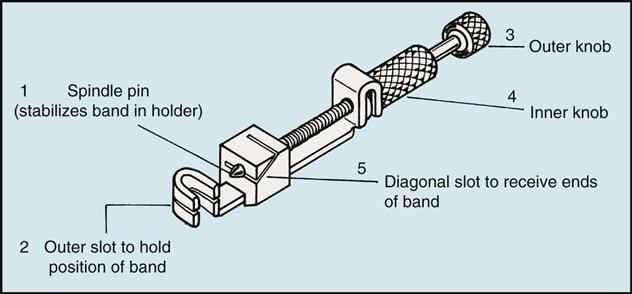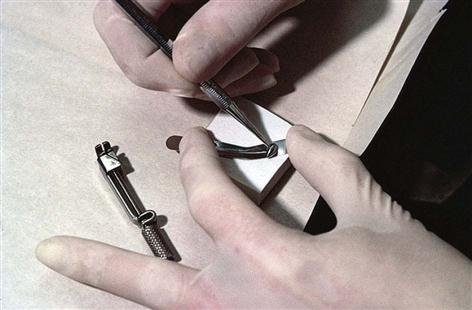Matrix Systems for Restorative Dentistry
Learning Outcomes
On completion of this chapter, the student will be able to achieve the following objectives:
• Pronounce, define, and spell the Key Terms.
• Describe the use of a matrix system in class II, III, and IV restorations.
• Describe the types of matrices used for posterior restorations.
• Describe the types of matrices used for anterior restorations.
• Discuss the purpose and use of a wedge.
• Discuss alternative methods for matrix systems used in restorative dentistry.
Performance Outcomes
On completion of this chapter, the student will be able to achieve competency standards in the following skills:
• Assemble a universal retainer and matrix band.
• Place and remove a matrix band and wedge for a class II restoration.
• Place and remove a matrix band and wedge for a class III restoration.
Electronic Resources
![]() Additional information related to content in Chapter 49 can be found on the companion Evolve Web site.
Additional information related to content in Chapter 49 can be found on the companion Evolve Web site.
![]() and the Multimedia Procedures DVD
and the Multimedia Procedures DVD
• Assembling a Matrix Band and Universal Retainer
• Placing a Matrix Band and Wedge for a Class II Restoration
Key Terms
AutoMatrix (aw-toe-MAY-triks) Matrix system designed to establish a temporary interproximal wall for the restoration of a tooth surface without the use of a retainer.
Celluloid (SEL-yoo-loid) strip Clear plastic strip used to provide a temporary interproximal wall for the restoration of an anterior tooth surface.
Cupping Form created by a concave tooth surface that has not been contoured properly.
Matrix (MAY-triks) Foundation that binds or holds the dental material and tooth together during the setting process.
Mylar (MYE-lahr) Brand name for clear plastic strip used to provide a temporary wall for restoration of an anterior tooth.
Overhang Excess restorative material that extends beyond the cavity margin.
Palodent (PAL-uh-dent) Small, oval-shaped matrix made of stainless steel used interproximally during tooth restoration.
Universal retainer Dental device used to hold a matrix band in place during restoration of a class II cavity.
When a tooth is prepared for a class II, III, or IV restoration, at least one interproximal wall of the tooth has been removed. A matrix system creates a temporary interproximal wall for the amalgam, composite resin, or intermediate restorative material to be placed against (Fig. 49-1). (The plural term for matrix is matrices.) Besides acting as a temporary wall, the matrix system has additional functions such as the following:
• To restore interproximal anatomical contours and contact areas of a tooth surface
• To create a smooth external surface for the restorative material to be packed against
Placement and removal of the matrix system may be a legal expanded function in the state in which you are practicing. Pay special attention to the type of tooth preparation, the type of matrix system to be prepared and placed, and the techniques of placement and removal.
Posterior Matrix Systems
The matrix system most commonly used today for the class II restoration is the universal retainer and matrix band. To avoid unnecessary delays in a procedure, the assistant will have the retainer and band assembled at the beginning of the procedure.
Universal Retainer
The universal retainer, also referred to as the Tofflemire retainer, is a mechanical device that holds the matrix band snugly in position. This type of retainer is positioned from the buccal surface of the tooth that is being restored.
If during tooth preparation, the interproximal wall extends onto the buccal surface, a contra-angle retainer has been designed with a slight bend in the body to accommodate positioning from the lingual surface.
Matrix Band
The matrix band is made of a thin flexible stainless steel material. The two designs of the matrix band most commonly used are the universal band and the extension band (Fig. 49-2). The universal band is selected for the class II preparation when the proximal “box” is prepared to a minimum depth and width and the cusps are intact. The extension band is selected for the deeper class II preparation requiring gingival extensions to compensate for the loss of a cusp, because insufficient height of a universal band will not exceed the height of the occlusal surface of the tooth as required.
The matrix band is designed in such a way that when the ends of the band are brought together, the band will form a circle. One side of the circumference (perimeter or outside edge) of the circle will be smaller than the other side. The circumference guides you in placing the band as follows:
Contouring
In preparation for use, the center of the matrix band should be contoured (shaped) in the proximal contact area, so the final restoration will have proper contact with the adjacent tooth. To contour the band, place the band on a paper pad. Using a burnisher or an end of the mirror handle, rub against the inner surface of the band until the ends begin to curl (Fig. 49-3).
See Procedure 49-1.
Stay updated, free dental videos. Join our Telegram channel

VIDEdental - Online dental courses






